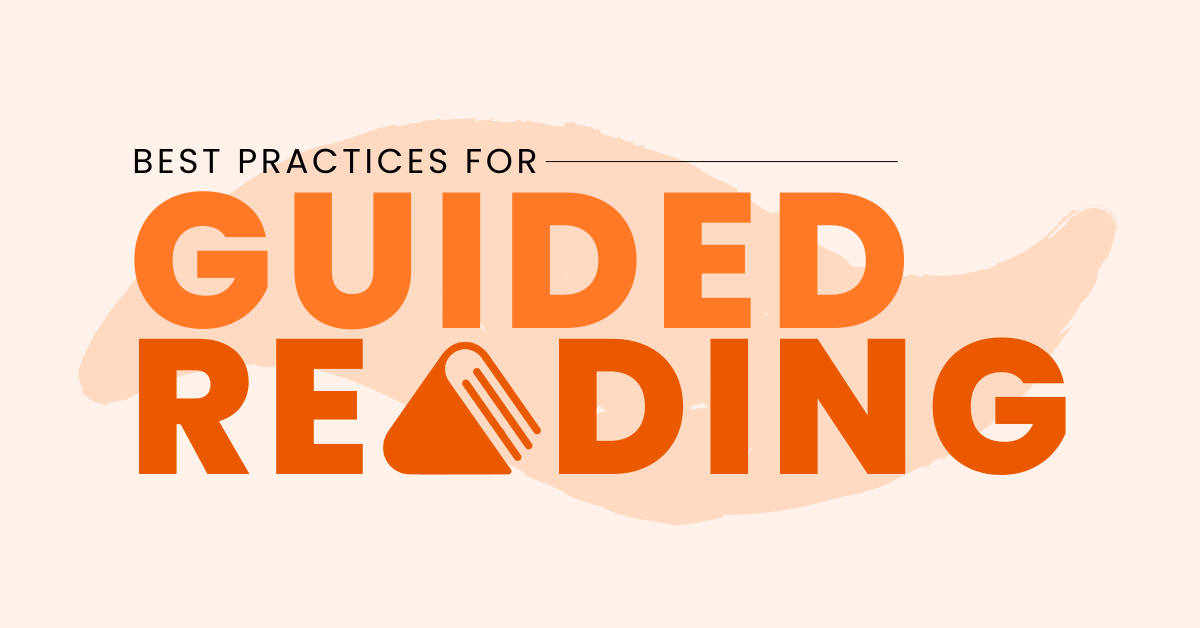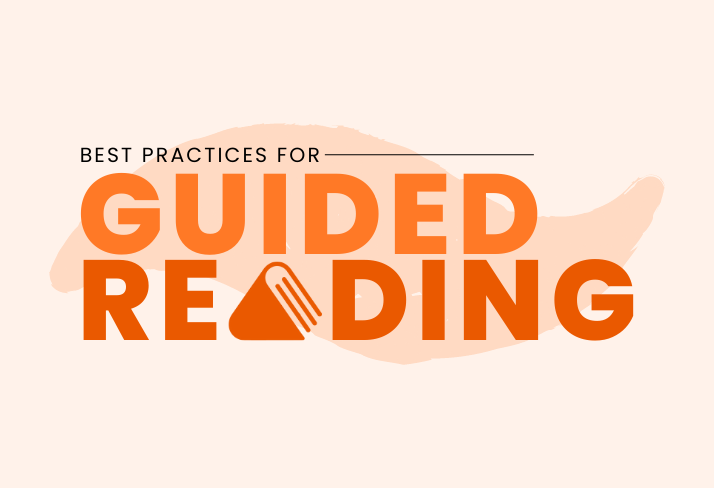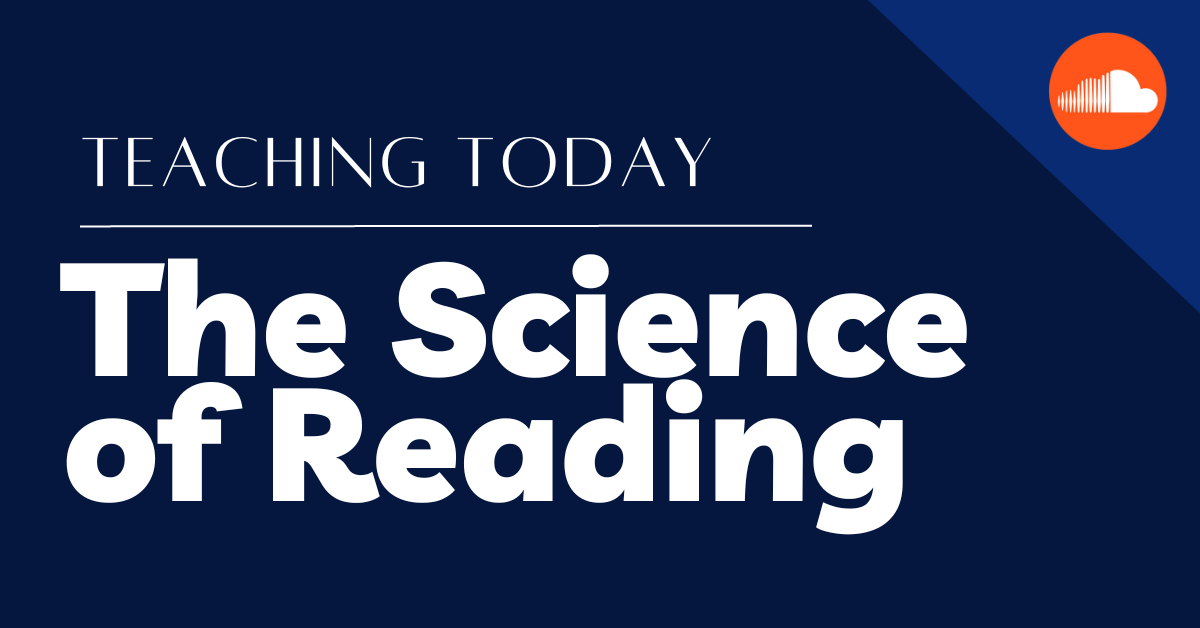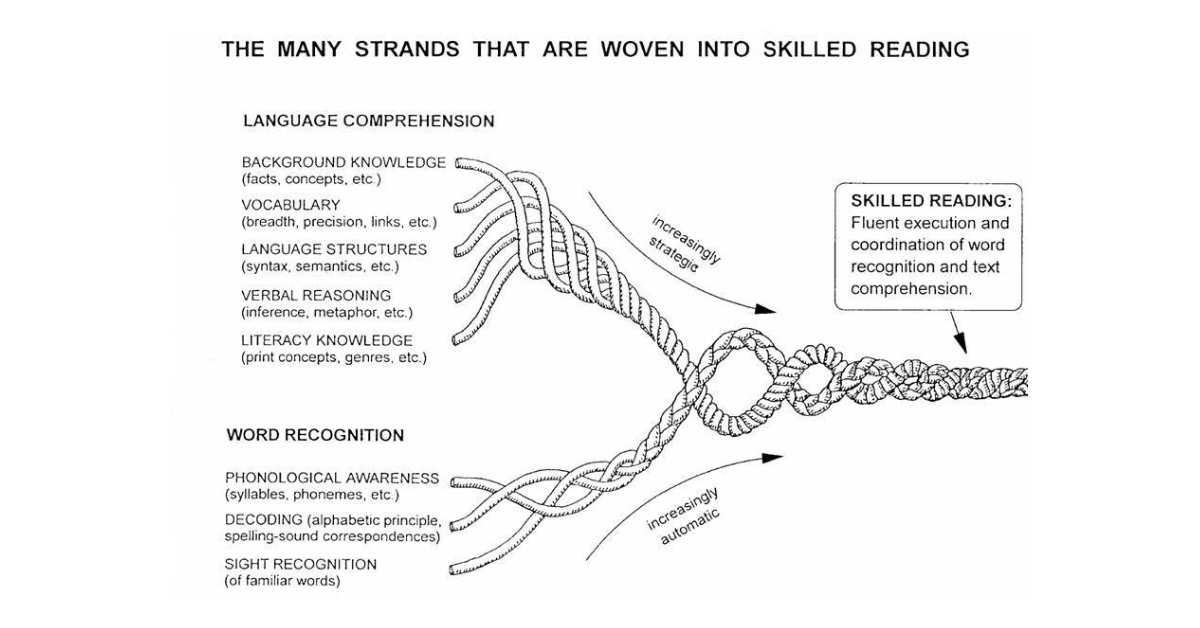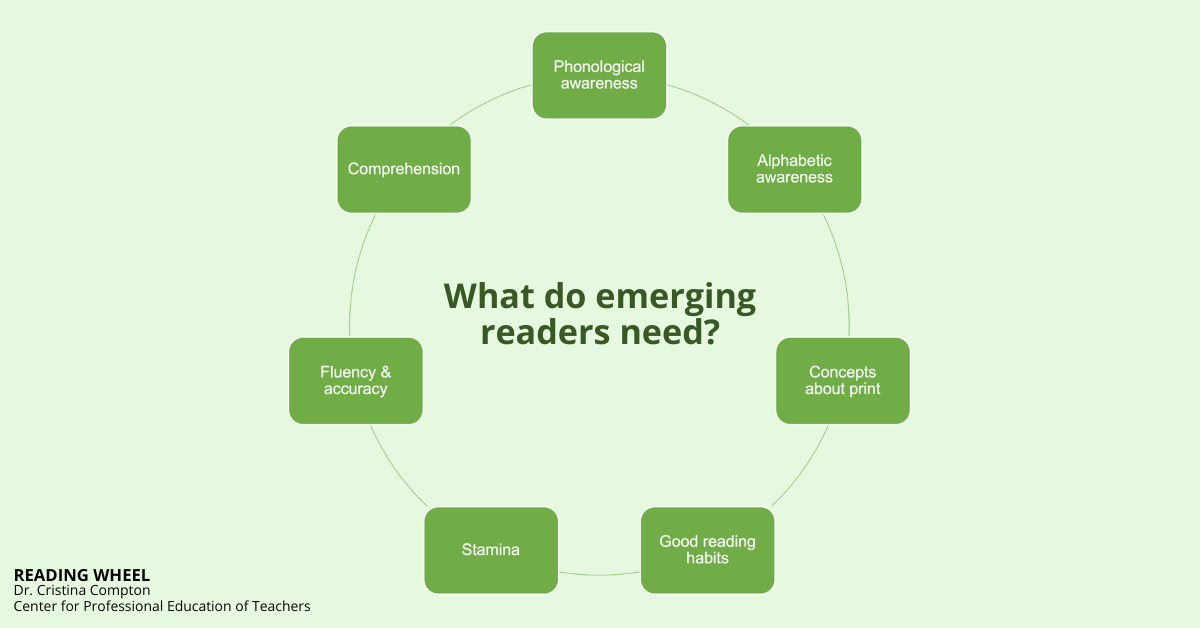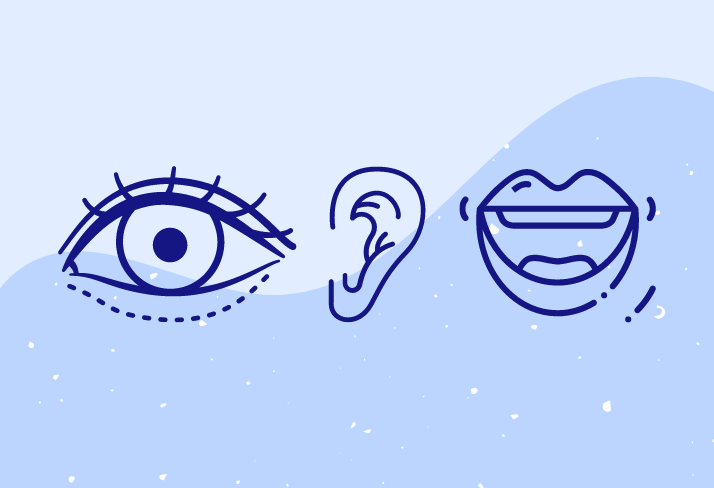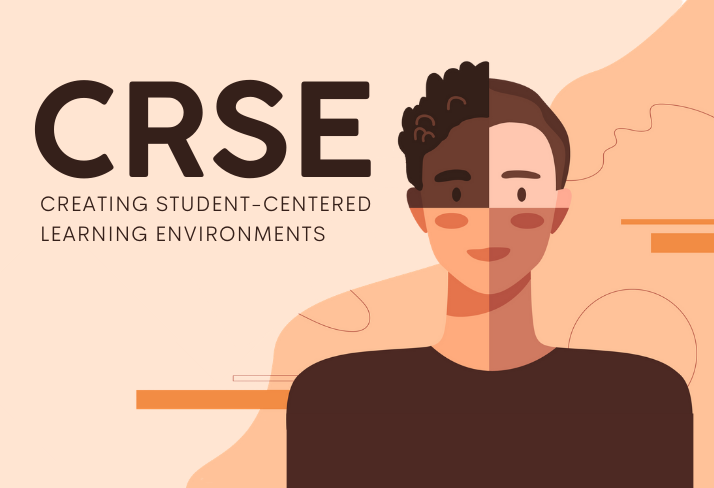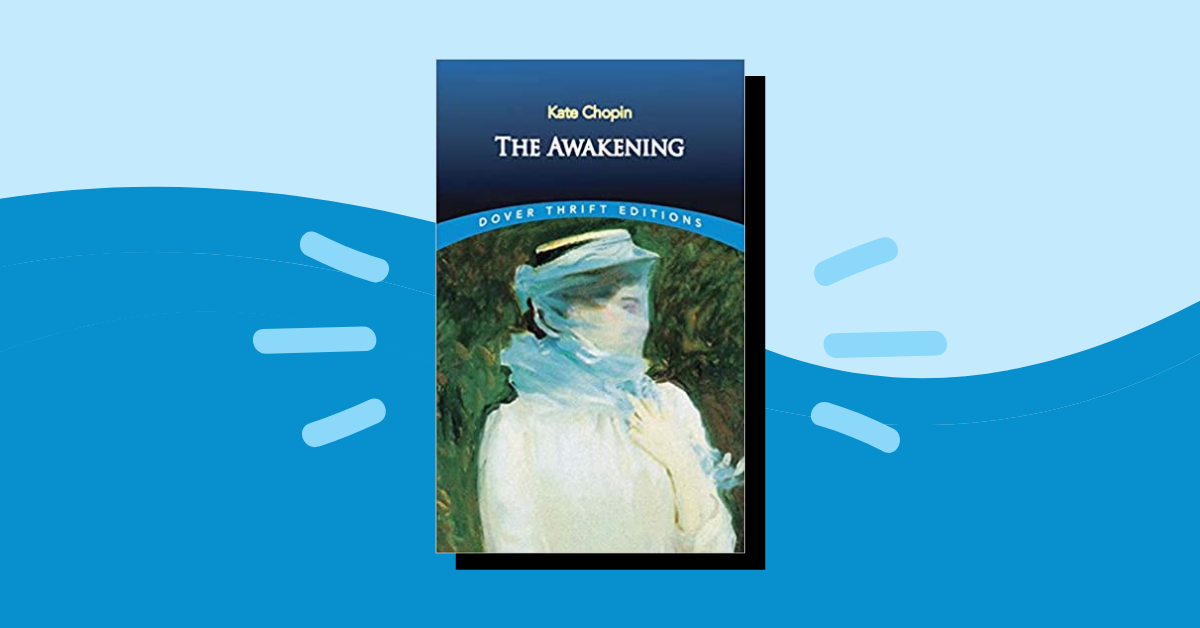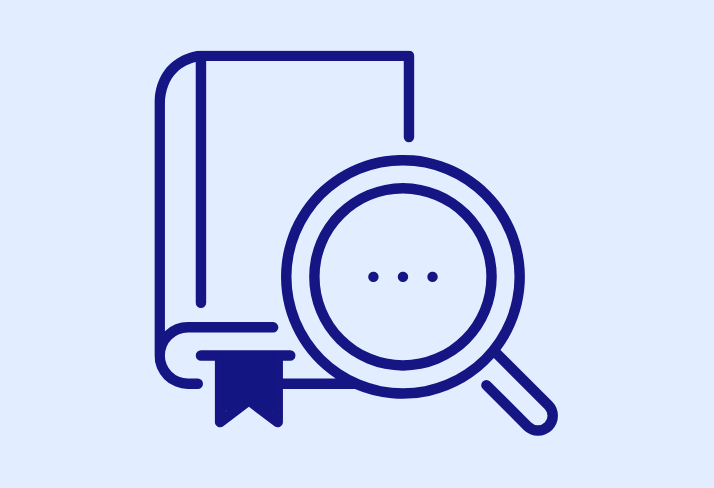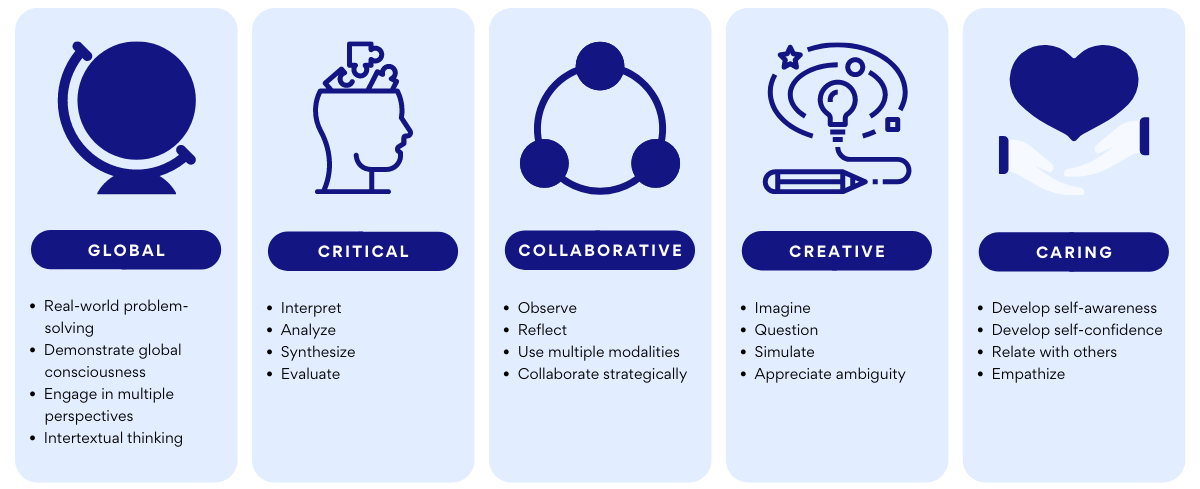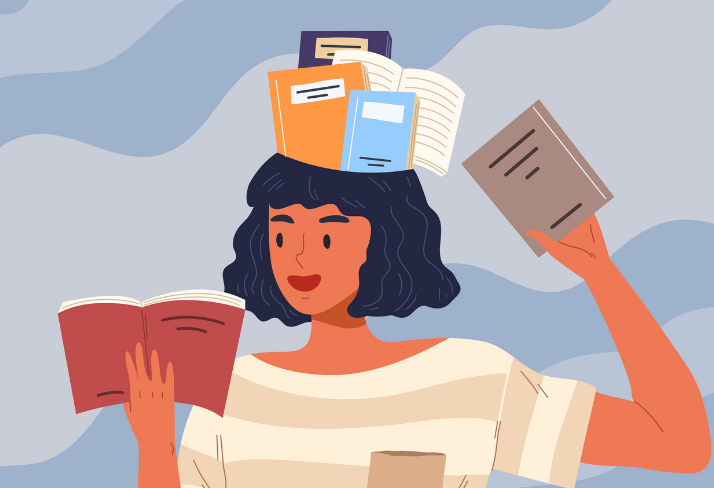|
Support emerging readers' vocabulary with a balance of explicit instruction and in-context learning.
This is the fifth installment in our Science of Reading series
Vocabulary is a crucial component of reading comprehension and literacy development. Understanding vocabulary and its significance is essential for educators as they work to support emerging readers on their journey to becoming skilled and proficient readers. In this fifth and final installment focused on the science of reading, we will unpack what vocabulary means, why it is important, and provide three promising practices that teachers can implement to effectively support emerging readers with vocabulary development.
What is vocabulary in the science of reading?
In the science of reading, vocabulary refers to the collection of words that a reader understands, recognizes, and can use effectively in their reading and writing. It encompasses both oral vocabulary (words we understand and use in speaking) and print vocabulary (words we recognize and understand in reading). Vocabulary development is a multifaceted process that involves word learning, comprehension, and retention.
Why is vocabulary development important?
Vocabulary serves as the anchor connecting various critical reading skills, fostering a deeper understanding of phonological awareness, phonics, and fluency. In phonological awareness, it enhances recognition and discernment of sounds within words, ultimately aiding in the decoding and pronunciation processes. When it comes to phonics, a robust vocabulary equips learners with the ability to detect word structures and pronunciation nuances, enabling them to effectively apply phonics rules during reading. Additionally, vocabulary ensures swift and accurate word recognition, which significantly contributes to reading speed and fluency. But perhaps most importantly, vocabulary enhances reading comprehension by giving readers the capability not only to recognize words, but also to understand their meanings within a text. Without a strong vocabulary, readers will likely encounter difficulties in grasping the core of what they are reading, ultimately hindering overall comprehension.
Promising practices for vocabulary development
Plenty of vocabulary strategies exist, but issues arise when one approach is excessively emphasized or prioritized, potentially leading to minimal or even neglected use of others. For example, overreliance on explicit vocabulary instruction may lead to isolated word memorization without a deeper understanding of word usage in context. An effective approach strikes a balance between explicit instruction and in-context learning. Below, I present three promising practices, as well as concrete examples of how I implemented these practices in my classroom. I believe these examples encompass various methods for explicitly supporting young readers' vocabulary development. Ideally, teachers will utilize all three practices, at different times, to create a comprehensive and holistic approach to vocabulary instruction.
Vocabulary development is a fundamental aspect of reading and literacy. In the science of reading, understanding what vocabulary is and why it's important is crucial for educators. By implementing explicit vocabulary instruction, contextual learning, and engaging word play and games, teachers can provide effective support for emerging readers, helping them build a strong foundation for successful, lifelong reading.
Incorporate active comprehension strategies that allow students to deeply engage with the texts they encounter.
This is the fourth installment in our Science of Reading series
Throughout our science of reading series, we've been exploring the crucial aspects of reading proficiency. In this installment, we will delve into reading comprehension, a fundamental skill that transcends the mere decoding of words on a page. Comprehension involves understanding, interpreting, and making meaning from the text. This ability is essential for success because it enables readers to connect prior knowledge with new information, make inferences, identify main ideas, and draw conclusions.
In the context of the science of reading, which emphasizes evidence-based reading instruction, reading comprehension holds a critical position. It recognizes that reading is not a single skill, but rather a complex interplay of various cognitive processes. Furthermore, it acknowledges that reading comprehension is built upon a solid foundation of phonological awareness, phonics, and fluency, as discussed in our previous articles. These foundational skills are essential for developing proficient readers, as they provide the necessary groundwork for understanding the content of the text. Now, let's delve into the significance of incorporating comprehension strategies alongside fluency and phonics, highlighting how they enhance the reading experience for students.
The power of active reading comprehension strategies
While fluency and phonics lay the foundation for reading proficiency, active comprehension strategies are the key to unlocking the true potential of these foundational skills. Fostering deeper understanding: Comprehension strategies encourage students to dive deeper into the text. When they actively make predictions, ask questions, visualize scenes, or summarize key points, they engage with the material at a greater level. This not only aids in grasping the surface level content, but also enables them to explore underlying themes, character motivations, and the author's intent. Bridging gaps in proficiency: Active comprehension strategies bridge the gap between students who excel in fluency and decoding, and those who struggle. For those proficient in these areas, comprehension strategies provide the tools to dig deeper and extract more meaning from texts. Meanwhile, students who may struggle with decoding and fluency can still make powerful inferences and predictions when they engage with comprehension strategies. This inclusivity ensures that no student is left behind in their reading journey. Promoting critical thinking: Comprehension strategies encourage students to analyze information, draw connections, and evaluate the significance of details within a text. This not only enhances their comprehension, but also equips them with valuable life skills that extend beyond the classroom. Building lifelong readers: The integration of comprehension strategies nurtures a love for reading. When students actively engage with texts, they become more invested in the reading experience. This can lead to a lifelong passion for reading and learning, setting the stage for continued growth and success.
Effective strategies for promoting comprehension
Incorporating comprehension strategies alongside fluency and phonics is essential for developing well-rounded readers. Below are three strategies I found to be particularly helpful for supporting comprehension in my young readers.
Explicit comprehension instruction
One way to promote comprehension is to provide explicit instruction of evidence-based strategies, such as making predictions, asking questions, visualizing, summarizing, and making connections while reading. Encourage readers to actively engage with the text by discussing their thoughts and insights. Model these strategies and provide ample opportunities for guided practice. By equipping students with these tools, you empower them to extract deeper meaning from the text. When I was in the classroom, I leaned on pre-, during-, and post-reading strategies and exercises that were focused on the asking of questions. By teaching my students to ask questions about the story, I helped them become active readers who think deeply about what they're reading and develop a better understanding of the text. An example lesson might look like:
Vocabulary development
A robust vocabulary is crucial for comprehension, as it bridges decoding skills like phonics and the ability to understand and enjoy texts fully. When students encounter unfamiliar words while reading, a well-developed vocabulary allows them to unlock the meanings of these words, making the reading experience more enjoyable and meaningful.
By integrating vocabulary instruction into reading lessons with a focus on context clues, students not only enhance their comprehension skills, but also strengthen their phonics abilities by recognizing and deciphering unfamiliar words within the context of the text. This holistic approach ensures that students not only decode words accurately, but also understand them in the broader context of the story. Building a strong vocabulary enhances comprehension by enabling students to grasp the nuances and subtleties of language.
Independent reading
In my classroom, I embraced the power of independent reading as a key component of our literacy program. Independent reading, also known as "personalized reading time," was a daily activity where my students had the freedom to choose books or materials that both matched their reading levels and piqued their interests. Studies have found that when students are allowed to choose their own reading materials, they are more engaged and invested in the reading process, resulting in improved comprehension (Guthrie and Humenick (2004)). To support independent reading, I ensured our classroom library was stocked with a wide range of books and magazines. This diversity catered to different reading levels, genres, and topics, giving each student ample choices. During independent reading time, students had the autonomy to select their reading materials, which fostered a sense of ownership over their reading experience, making it more engaging and enjoyable. I worked closely with each student, mostly through conferencing, to ensure they selected books that matched their reading levels. This ensured that the material was neither too easy nor too challenging, promoting comprehension and confidence. To enhance comprehension and encourage reflection, I periodically organized book discussions or "book talks." If multiple students were reading the same book, we would gather for a group discussion. In these sessions, students had the opportunity to share their thoughts, insights, and favorite parts of the book. It promoted a sense of community and enthusiasm for reading. After each independent reading session, I encouraged students to reflect on what they had read and set personal reading goals. This reflection helped them track their progress and set targets for improvement. Lastly, students kept reading journals where they recorded the titles of the books they read, brief summaries, and personal reflections. These journals served as a valuable tool for tracking their reading journey. By incorporating independent reading into our daily routine, my students not only improved their reading comprehension, but also developed a genuine love for reading. It was a practice that empowered them to explore diverse texts, share their reading experiences, and become lifelong readers.
Elevating comprehension
By integrating explicit comprehension instruction, vocabulary development, and independent reading, educators can establish a holistic approach to literacy that extends beyond fluency and phonics. This approach ensures that students not only read accurately, but also engage deeply with, analyze, and appreciate the texts they encounter, equipping them with the full range of skills essential for reading development and proficiency.
Nurture confident readers by blending phonics into the fabric of your literacy instruction.
This is the third installment in our Science of Reading series
When it comes to early reading instruction, few topics have sparked as much debate and controversy as the teaching of phonics. Over the years, the pendulum has swung between extremes: some advocate for phonics as the exclusive focus of instruction, while others argue for its complete exclusion from the curriculum. However, the crux of effective literacy education lies in finding a harmonious balance. As part of my series dedicated to unraveling the science of reading and nurturing young readers, we embark on a journey into the world of phonics. What exactly is phonics, what role does it play in reading development, and how can early childhood educators incorporate it into their classrooms through a balanced approach?
Defining Phonics: The Foundation of Reading
At its core, phonics is the relationship between the sounds of spoken language and the letters that represent those sounds in written language. It's the code that unlocks reading comprehension. Phonics instruction involves teaching students how to connect the sounds of spoken language (phonemes) to the symbols (letters or letter combinations) that represent them (graphemes). We dig deeper into this topic in my previous article, which examines how to nurture phonological awareness in emerging readers. Phonics equips young readers with the skills needed to decode words — without phonics, the process of learning to read would be like trying to solve a complex puzzle without understanding the individual pieces.
The Purpose and Importance of Phonics
Phonics serves several crucial purposes in the development of young readers: Decoding Words: Phonics provides the key to unlocking unfamiliar words in texts. When students understand the relationships between sounds and letters, they can sound out words they haven't encountered before. Building Fluency: Proficiency in phonics helps build reading fluency. Fluent readers can read with accuracy, speed, and expression, which enhances comprehension, as we have discussed in previous articles. Spelling Proficiency: Phonics instruction also contributes to spelling skills. When students know the sounds associated with letters and letter combinations, they can spell words more accurately.
Balancing Act: The Key to Phonics Success
A balanced approach to phonics instruction is essential in literacy education for several reasons. Firstly, it facilitates a well-rounded development of essential reading and writing skills, encompassing phonemic awareness, fluency, vocabulary, comprehension, and writing proficiency. This holistic perspective acknowledges and embraces the diversity of learners, accommodating various learning styles and individual needs. The integration of phonics within authentic reading and writing contexts is a critical aspect of this approach. By immersing students in real-world applications of phonics skills, it not only reinforces learning, but also enhances reading fluency. This equips students with a range of word recognition strategies, lessening their reliance solely on phonics, and thereby improving reading efficiency. Furthermore, a balanced approach recognizes that the ultimate goal of reading is comprehension. It weaves phonics instruction together with comprehension strategies, ensuring that students not only decode words, but also understand and interpret the text they read. Creating a balanced approach to instruction can offer essential support for struggling readers, tailoring instruction to meet their specific needs and providing a scaffold for their literacy development. Ultimately, it fosters a deep appreciation for literacy, nurturing lifelong reading and writing habits, and in doing so, it aligns with evidence-based practices in literacy education.
A Balanced Approach In Action
As a third-grade teacher, I often recognized the need to teach phonics to specific groups of students, even though it wasn't a part of the standard curriculum. One approach I used was phonics through literature, where I selected books featuring specific phonics patterns, and integrated phonics instruction within shared reading sessions. For example, if I wanted to focus on the long a sound spelled with the silent e pattern (e.g., "cake," "gate”), I could use a book like Jake Bakes Cakes, which prominently features words with this pattern. I would then use this text to engage in a shared reading session, where I read the book aloud to the class, pausing at words with the target phonics pattern. For instance, when we encountered the word cake, I might emphasize the long a sound and point out the silent e at the end of the word. After reading, I would engage the students in a discussion about the phonics pattern, asking questions like, "What sound does the e make at the end of the word cake?" or "Can you find other words in the story with the same pattern?" To support word recognition, I would encourage students to identify and read words with the target pattern in the book. They might take turns reading sentences or identifying words on specific pages. I would also have students use magnetic letters or word cards to demonstrate how changing the vowel sound (e.g. cake to make) affects the word's pronunciation and meaning. Students would then manipulate letters to create new words following the same pattern. If there was time, I would also ask students to engage in word play activities related to the phonics pattern, such as creating rhyming words or making word family charts, to reinforce the concept. As a follow-up activity, students might be encouraged to write their own sentences or short stories using words with the target phonics pattern. The key idea behind phonics through literature is that phonics instruction is embedded within the context of enjoyable and meaningful texts, fostering a love for reading and connecting phonics to authentic language usage. I found that my students were highly engaged in these activities, and they proved to be beneficial to their development as readers.
In summary, the teaching of phonics is a foundational component of early literacy instruction. It equips young readers with the tools needed to decode words, build fluency, and enhance spelling skills. However, the key to effective phonics instruction lies in balance — it's not about choosing between phonics all the time or not at all; it's about blending phonics into the fabric of literacy instruction.
By incorporating phonics into shared reading, fun activities, and explicit instruction, early childhood educators empower their students to become confident and skilled readers. In the next installment of our series, we will explore comprehension strategies, bringing us one step closer to unlocking the full potential of our young readers. Stay tuned!
Encourage meaningful reading habits as you ask students to engage in a dialogue with their text.
Over the past few years, I have heard more and more middle and high school teachers agree about how difficult it is to “get kids to read." I have observed myself that few students seem to be reading full length books independently, and by choice. Of course, there are so many reasons for these observations.
Let’s zoom out a bit to think about the state of reading for most of our students: in the past, reading was not only a major form of entertainment, but a crucial source of information. Time for reading was not in competition with an expansive, alluring digital world offering games, web surfing, Tik Tok, Instagram, endless TV and YouTube channels, etc. Even as adults, we know how easily accessible and comforting these modalities are. Technology offers us so many easy, even addictive options. Technology has also made it easier for students to “read” or pretend they have read an assigned text by scanning summaries of chapters, Googling quotations from the text, watching video versions, etc. Information that we may have needed to access by reading a book is now available at the click of a finger or by saying a few words to AI. We have all been there — we even have a term for this, tl;dr, or too long, didn’t read. Research confirms my own observations that few young people are reading on their own or consider “reading for pleasure." The Pew Research Center asserts that, “few late teenagers are reading many books” and a recent summary of studies cited by Common Sense Media indicates that American teenagers are less likely to read ‘for fun’ at seventeen than at thirteen.” The pandemic also seems to have derailed some students’ academic reading habits, which have proven to be like muscles that need to be exercised more regularly than we previously knew. All of this means that if we want our students to read, to become strong, confident readers, and maybe even enjoy reading, it is crucial for educators to make reading meaningful and relevant for our students, and not simply “cheat proof."
Encouraging students to read
Offering students choices of relevant books to read and discuss together in book groups or pairs is a fantastic way to encourage them to engage in reading. However, most educators agree that reading a book together — as a shared “anchor text” for the whole class — can also be important and lead to powerful discussions and collective learning. Mike Epperson — a teacher with whom I work closely in the South Bronx — took the opportunity to bring a shared anchor text to his 10th grade classroom, introducing his students to Elie Wiesel’s Night. While Night is a riveting, significant story and a relevant choice for 10th graders, who are concurrently learning about World War II and the Holocaust in history class, that doesn’t guarantee that students will engage in the reading. Mike was concerned about ensuring that his students were both engaged deeply and personally in the important subject matter and took it seriously. He decided early on that he wanted students to read the entire book. Mike strategically layered his teaching unit with Night at its core, along with supports and entry points to encourage high engagement, including: background building about the Holocaust, Anti-Semitism, and Judaism, and a careful sequence of lessons that focused on a key topic in a section of the book. Additionally, to encourage reluctant or less confident readers to read daily and remain engaged in reading the whole book, Mike emphasized and taught annotation. Since the school had copies of the book left over from ordering during the pandemic, Mike was able to give each student their own book to write in and keep. These two simple pieces — students having a book of their own and an opportunity to talk back to the text through annotation — created an environment ripe for close reading and high engagement.
Encouraging students to annotate
Getting students to annotate in their actual books wasn’t as simple as Mike had expected — he recalls that “when we first started annotating, some students expressed resistance because they didn’t want to make the nice-looking book look ugly. One student compared it to writing on a beautiful painting with crayon.” However, as time went on, students were “able to find a way to annotate that helped them preserve the beauty of the original text. I believe that as students took on a self-appointed role as the book’s preservationists, they ended up developing a deeper respect for the content of the book as well.” As the students connected more personally with the book and the character of Elie, Mike began to see that the act of authentic annotation was offering students an unanticipated opportunity for creative expression. He shared that “a lot of students like drawing, and there’s a similar appeal in annotation. While annotating is not drawing, a fully annotated page is visually pleasing. Some students’ annotations are neat, symmetrical, and visually appealing in a way that suggests that students take pride in how their annotations look. I think this fosters a sense of pride in the content of their annotations, too.” Mike’s observations of his students’ annotations confirm the belief that writing as you read makes your thinking visible, and can create an engaging conversation as we talk back to the text. He puts it simply: “Annotation gives the students a more active role in reading. They get to have a voice, even if no one else will see their annotations.” The students are no longer alone with a book. They are in dialogue.
Suggestions for successful annotation
When I visit Mike’s classroom, students eagerly show me their annotations and explain the significance of both specific lines on a page and their connections to larger themes. A number of students also tell me how much annotation is helping them “remember’ and “understand” past parts of the story. They are clearly proud of their text marking and meaning-making. Based on my observations of Mike’s classes, I’d like to offer some simple tips for making annotation a successful approach with your own students:
Hopefully, you will feel inspired to introduce or continue using annotation in your classroom! As you encourage students to read with their pen and engage in a dialogue with a text, feel free to adjust any of the strategies above to match the readers and annotators in your classroom.
Equip readers with the tools needed to recognize and manipulate sounds embedded within language.
This is the second installment in our Science of Reading series
As the science of reading becomes more influential in the field of education, it is important for us to not only accept and incorporate the principles in our practice, but also make sure we fully comprehend the essence and significance of what it means. Because I am an elementary educator and instructional coach dedicated to nurturing emerging readers, my commitment lies in breaking down the intricacies of the science of reading, while providing support for our young readers' development.
Phonological awareness — much like fluency, the topic of my previous article in this series — serves a crucial role in shaping a child’s reading journey. In this article, I intend to define phonological awareness and offer practical insights for fellow educators. Drawing from my experiences in the classroom as well as my own reading and research, I will explore its significance, its alignment within the science of reading, and provide guidance on fostering it effectively in early childhood settings.
Defining Phonological Awareness
Through my pre-service training, my experiences in the classroom, and ongoing reading and research, my understanding of phonological awareness has crystallized as the capacity to recognize and manipulate the sounds embedded within spoken language. Imagine it as a playground of sounds within the mind, where children identify rhyming words, dissect sentences into syllables, identify individual sounds (phonemes), and play with the rhythm of language. Like fluency, this skill is crucial, serving as the foundation for reading readiness. Strong phonological awareness equips children with the tools to decode words, comprehend texts, and eventually become proficient readers and writers. In essence, phonological awareness is akin to the scaffold that supports the acquisition of language, empowering children to construct sentences, paragraphs, and stories with confidence. It encompasses the following micro-skills:
Strategies for Supporting Phonological Awareness
Recognizing its significance, I have dedicated considerable time to identifying effective strategies and promising practices to support phonological awareness. Drawing from strategies I utilized as a third-grade teacher, coupled with observations from visits to flourishing early childhood classrooms, I want to share three promising practices:
These practices, while adding an element of enjoyment to learning, lay the groundwork for phonological awareness, preparing the stage for successful reading development.
Embracing Phonological Awareness
In the world of reading science, phonological awareness plays a vital role, mixing together words, sounds, and understanding. Just as fluency helps connect understanding and reading, phonological awareness serves as a crucial link between grasping the tiniest sounds within words (phonemic awareness) and linking these sounds to letters (phonics). When we nurture this skill, we help kids confidently deal with reading challenges and build on the fluency we talked about in article one. By recognizing the importance of phonological awareness and finding effective and engaging ways to teach it, we ensure every child embarks on their reading journey with a strong foundation, unlocking the power of literacy and lifelong learning.
Navigate reading mastery and the science of reading to create meaningful instruction for young readers.
This is the first installment in our Science of Reading series
In the realm of reading instruction, fluency acts as a foundational cornerstone, shaping the way readers interact with written language. Often hailed as the bridge connecting decoding and comprehension, fluency plays an instrumental role in molding a reader's overall understanding. This article takes a comprehensive look at the concept of fluency, delving into its significance, practical implications, and its alignment with the science of reading, with a particular focus on the role of guided reading.
Defining Fluency: Beyond the Basics
Fluency in reading goes beyond just being able to read words correctly. It involves reading in a way that is smooth, precise, and with expressive intonation. It also includes accuracy in understanding the text, maintaining a suitable reading speed, and paying attention to prosody, which refers to the rhythm and melody present in language. When all of these elements come together, they transform reading from a basic recognition of words into a skill that allows you to effortlessly comprehend the deeper significance of a text.
Why Fluency Matters: Bridging Decoding & Comprehension
Fluency acts like a bridge that connects two important parts of reading: decoding and comprehension. Decoding is the process of breaking down written symbols into recognizable words, while comprehension involves understanding the true meaning of the text. When a reader becomes fluent, it means they can decode words effortlessly, which in turn frees up mental energy. This newfound mental capacity can then be directed towards better understanding the content of the text. Research has shown a strong connection between fluency and comprehension. Readers who have developed fluency are not only able to grasp complex ideas easily, but also engage in critical analysis of the text. This skill in turn helps them develop a genuine fondness for reading. This dynamic relationship between fluency and effective reading instruction is a central focus within the science of reading.
Guided Reading: A Path to Proficiency
In the array of strategies aimed at promoting fluency, guided reading emerges as a standout approach. Within a guided reading context, small groups of students engage in shared reading experiences, guided by their teacher. The strength of guided reading lies in its ability to:
Guided Reading in Action: Effective Approaches
Elevating Fluency: A Reading Journey
Fluency goes beyond a mere skill; it's the foundation of satisfying, meaningful reading. Guided reading plays a key role in nurturing this skill, supporting capable readers, and fostering a genuine passion for reading. As educators embrace the principles of guided reading and other fluency-centered approaches, they empower young minds to confidently navigate texts. This involves actively connecting and interlinking various elements within the text, much like weaving threads into a fabric. This journey blends the art of reading with the science of effective reading instruction, resulting in a community of skilled and enthusiastic readers. If you are interested in exploring guided reading further, join me at Best Practices for Guided Reading, which will provide you with an opportunity to experiment with designing and implementing guided reading lessons of your own!
Why simply adopting new programs will not guarantee improved reading scores.
Recently, the chancellor of New York City public schools, David Banks, announced a significant change in reading instruction by introducing three researched-based programs with a focus on phonics. While this shift aims to address the flawed approach to teaching reading, it also raises questions about the shortcomings of the current system and the potential consequences of relying solely on phonics instruction.
In this article, I raise concerns about the new programs, the importance of a balanced approach, and propose investing in professional development to improve existing efforts.
Flawed approach to teaching reading
David Banks criticized the City's approach to teaching reading as fundamentally flawed and failing to align with the science of how students learn to read. However, the exact shortcomings are not explicitly defined. Was it the lack of phonics instruction or insufficient emphasis on it? Furthermore, the effectiveness of the current approach seems to be evaluated based on standardized exam scores, which doesn’t provide a comprehensive picture of student learning.
New programs and concerns
The new programs being offered to schools, such as Wit and Wisdom, Expeditionary Learning, and Into Reading, each have their strengths and weaknesses. Wit and Wisdom emphasizes knowledge building but lacks explicit phonics instruction, requiring schools to adopt an additional phonics program like Fundations. Expeditionary Learning includes explicit phonics instruction, but Into Reading has faced criticism for its lack of cultural responsiveness. It is crucial to recognize that there is no magic bullet. No single program can meet the diverse needs of all students, and simply adopting new programs does not guarantee improved reading scores.
Maintaining foundational reading practices
I am not against explicit phonics instruction; however, I want to advocate for the preservation of foundational reading practices, such as read-alouds, independent reading, and shared reading — all of which promote fluency, comprehension, and vocabulary development. While phonics instruction is necessary, it should not overshadow these essential practices that nurture a love for reading and promote student autonomy when it comes to book selection. It is concerning to me that the science of reading is being equated solely with decoding and phonics, which I believe will lead to an overemphasis on this aspect of instruction. Given the limited time available for reading instruction during the school day, other important reading activities may be deprioritized or excluded altogether. This narrow focus could have negative implications for teachers, students, and their overall reading experiences. To teach reading comprehensively, it is essential to consider the interplay between different reading skills. Chancellor Banks highlighted five essential skills reflective of a competent reader:
But these skills are not sequential. They are interconnected and should be taught in a way that recognizes their interdependencies.
Investing in professional development
Rather than perpetuating the narrative of a reading crisis and introducing new programs in haste, I would urge us to invest in professional development for teachers and leaders. This approach would enable them to delve into the science of reading, understand its implications, and identify the most effective ways to teach reading skills. By focusing on all aspects of reading development — phonological awareness, phonics, vocabulary, fluency, and comprehension — current efforts can be improved, specific curricula can be adapted, and supplementary strategies can be identified.
Encourage students to expand their repertoire of ways to read and respond to literature.
As someone who loves to read and write, one of my favorite things to do is annotate texts — whether it be a few scrawled words in the margins of my most beloved hardcover books or endless questions written on sticky notes falling out of flailing paperbacks, my annotations capture the spirit of my hyper-personal engagement with a text.
When I became an English teacher, I knew that I wanted my students to learn how to annotate, in part because I wanted them to capture their noticings and wonderings as they engaged in their own distinctive reading process. In “Literature as Exploration” (1995), Louise Rosenblatt wrote that every person has a unique, transactional experience when they read a text, in which they “live through” something special. I think of annotations like mementos of this special reading experience because they capture a moment in time in the transactional experience that would otherwise be lost. Every time we read a text, even if it’s one that we’ve read hundreds of times before, we encounter a new transactional experience. As we annotate and re-annotate texts, we leave behind a trail of our reading experiences: our questions, thoughts, and wonderings. I desperately wanted my students to develop that experiential, transactional trail of their reading processes.
The Traveling Text
Imagine my surprise when I discovered, as a new teacher, that my students often responded to my call for annotations with, “I don’t know how to annotate!” or “Can you tell me what to annotate for?” or, worst of all, “I hate annotating. It’s a waste of time.” I can recall my naive shock when I heard my students respond in this way. In a desperate attempt to show my students the value of annotating, I began tirelessly modeling annotation strategies and my own methods of annotation, but doing so yielded little success. With time, I developed an incredibly simple strategy for teaching my students to annotate. Essentially, I stopped teaching my students to annotate through direct instruction and, instead, encouraged them to teach one another. This instructional strategy was, in my teaching, a solution to the problem of students feeling like they “don’t know” how to annotate or that annotating has “no purpose.” I call this strategy The Traveling Text (download here). The Traveling Text is simple, requires minimal teacher preparation, empowers students, builds community, and teaches annotation skills. And implementing this strategy with your students only takes four steps.
The impact of The Traveling Text
In my teaching experience, here are some of the impacts of this strategy on my students and our classroom community:
Teaching students to read for meaning (and for pleasure) is a daunting task. Often, our students come to us already feeling like they don’t know how to read and annotate literary texts in the “correct” way, one that highlights what a teacher or evaluator might be looking for.
The Traveling Text creates possibilities for students to expand their own repertoire of ways to closely read and respond to literature. But, even more importantly, the strategy encourages students to experience a sense of intellectual community and belonging with their classmates as they share with one another written artifacts of their own transactional reading experiences.
Breaking down the science of reading to identify specific skills & supports for emerging readers.
Many people are talking about the science of reading — a term that is certainly not new, but has been gaining some serious traction recently, and prompting some heated debate. This debate largely stems from how this term is being interpreted and what this means for the students in our classrooms. What is truly meant by the science of reading?
After doing some of my own research, I’ve come to understand the science of reading as a comprehensive body of cross-disciplinary research conducted over the last 20 years that deepens our understanding of how the brain learns to read, including what skills are involved, how these skills are connected, and which parts of the brain are responsible for our reading development. The research seems clear, but because the term has become so loaded, I believe we are losing sight of what our young learners really need to become strong, capable readers.
What makes a skilled reader?
One of the leading researchers of early language development and its connection to later literacy, Dr. Hollis Scarborough, developed in 2001 what she termed the Reading Rope, which helps us articulate the specific skills readers need to have in order to be proficient. The rope consists of lower and upper strands, with the upper strand focusing on language comprehension, and the lower strand emphasizing word recognition. All these micro skills start to work together through practice and repetition, so that these skills can become instinctive. Ideally, over time, language comprehension becomes more strategic and weaves together with word recognition to produce a skilled reader.
I have greatly appreciated Dr. Scarborough’s work, and recognize connections to how I have and continue to talk about the reading development in my coaching work. Despite using a few different terms, we have similar meanings. What she describes as literacy knowledge, I have described as concepts about print. Similarly, we talk about comprehension as consisting of micro skills including vocabulary and background knowledge — the skills needed to make sense and meaning of a text.
However, I have gone a bit further in my explanation of what emerging readers need and have developed the Reading Wheel, which is based on my understanding of research and my experience as a childhood educator, teaching students how to read.
You’ll see that, in addition to phonological awareness, I include alphabetic awareness, which is defined as “knowledge of letters of the alphabet coupled with the understanding that the alphabet represents the sounds of spoken language and the correspondence of spoken sounds to written language.”
I also discuss the importance of good reading habits, which include what Dr. Scarborough describes as verbal reasoning and a few others. Good reading habits are those often taken for granted skills that proficient readers use when reading — predicting, evaluating, questioning, clarifying, and monitoring for meaning, for example. In my work with teachers, I try to have them engage in the reading of a text, and then reflect on some of the moves they made while reading, to help reveal the habits they utilize most, and how these might be incorporated into their teaching. I also include a specific focus on stamina, which I define as the skill of being able to read for longer and longer periods of time, and the willingness to keep reading, even when it feels hard.
What support do readers need?
To me, all these skills are equally important. The problem arises when we place more value or importance on certain skills over others — e.g., word recognition over language comprehension, which has often resulted in phonics instruction, all the time! Phonics instruction has its place when it comes to helping children learn the relationships between the letters of written language, the sounds of spoken language and supports their phonemic awareness and decoding skills; however, phonics instruction alone would not suffice. Emerging readers need opportunities to recognize the word patterns and letter blends in context, as they show up in books. If we look closely at both Dr. Scarborough’s Reading Rope and the Reading Wheel, we’ll see that they underscore the importance of being able to read words AND make meaning, evident by the weaving of the individual threads of the rope and the circular nature of the wheel. Students need explicit instruction when it comes to developing comprehension skills, in order to support them in thinking critically, making connections, and developing their identity as readers. Young readers need differentiated instruction and in the moment feedback as they work to progressively read more complex texts. This often happens during readers' workshops, or small group instruction, such as guided reading. Lastly, children need opportunities to engage in independent reading and participate in read alouds, to gain exposure to a wide range of texts aligned to their needs and interests, to grapple with different topics and content, to help foster a love for reading, promote stamina, and learn meaningful habits from a skilled reader — their teacher. My students loved read alouds, and often begged me to read more, so they could find out if Clover and Annie end up as friends in The Other Side, or find out if and how the teacher will respond to the class making fun of Chrysanthemum, or find out the connection between Kissin’ Kate Barlow and the Warden in Holes.
As Diana Townsend states, “If we really care about teaching kids how to read, we need to focus on creating space and time for teachers to enhance their professional knowledge." They need time to explore the research around reading development for themselves and engage in conversation with colleagues about how it should inform their instructional strategies and approaches, rather than relying on a packaged curriculum or reading programs to do it for them.
Furthermore, there needs to be meaningful and ongoing inquiry, where teachers can try things out, and then reflect on what’s working, when, for which readers, and why, as we know it takes time and patience to get things “right.” At the end of the day, Townsend reminds us that, “no one is going to ‘win’ the reading wars and children will always be the losers.”
Help students independently investigate and interpret unfamiliar words using context clues.
When it comes to reading, one of the most significant challenges students face is vocabulary. If students come across a word they don’t know while reading, it can have a substantial impact on their comprehension and their confidence. I witnessed this as a classroom teacher, and I’ve heard it from many of the teachers I now coach.
Searching for clues
One of my most tried and true strategies, which I used in my own classroom as an elementary teacher, and one I continue to offer to teachers, involves encouraging students to read texts like a detective who is searching for clues. Asking them to engage in this way encourages students to look for clues that can help unlock meaning, offer insights, and assist them in interpreting unknown words. But these clues — often referred to as context clues — go beyond the language immediately surrounding unknown words. Clues might be found in the paragraph before or after an unknown word or phrase. Sometimes there are clues in the text features, including pictures, visuals, captions, or word boxes. We need to support students in treating the whole text as a series of clues that can help them become familiar with specific vocabulary words as they read independently.
Monitoring for meaning
Our Monitoring for Meaning resource can support students with this process, particularly when it comes to identifying and investigating difficult words. It offers a helpful template that prompts students to:
This resource asks them to use their best guess and then either confirm or revise their thinking after using a dictionary. Furthermore, it prompts students to lean on their prior knowledge to help decipher new words.
Literacy teachers have the demanding and important task of teaching reading, and while there is no single strategy that can guarantee success, encouraging curiosity and investigation while reading is a high leverage way to support students in becoming competent, confident readers.
Encourage curiosity and caring in young learners, and support an understanding and appreciation of differences.
Conversations about race are not easy. They can bring about feelings of fear, anger, and frustration, and as a result, these conversations are often avoided. However, grappling with topics of race and diversity are truly important, especially with young children who are cultivating their understanding and their perceptions of the world. Experts argue that children are never too young to learn about kindness, fairness, and human rights. Research states that children “as young as three months old...may look differently at people who look like or don’t look like their primary caregivers.”
As a parent of a soon to be two-year-old and a professional development consultant who works closely with educators of young children, I am committed to seeking ways to engage in and facilitate my own conversations about race, especially in today’s world, as well as share strategies with educators that they can use in their own classrooms. What follows are a few strategies I’ve curated and adapted from my own musings and readings, as well as some concrete strategies inspired by one of our reimagining education initiatives: Literacy Unbound. These strategies can be particularly helpful when it comes to facilitating conversations about race with young students and cultivating skills, mindsets, and capacities that will serve us well today, and in the future.
The importance of asking questions
One of the most effective ways to grapple with topics of race and diversity is to ask questions. This is particularly effective with elementary students, as they commonly ask many questions of their own. By encouraging their curiosity and caring, and creating a safe space for them to be inquisitive, you can help pacify concerns, address confusions, and support an understanding and appreciation of differences. Additionally, you can raise your own questions focused on topics of race, diversity, and exploring differences to get students thinking and recognizing how they can be advocates of positive change. Here are some examples of questions that I turn to, curated and adapted from websites like PBS.com:
These questions can be a part of morning circle time, a weekly reflection or journal writing prompt, or even as a theme for a bulletin board, where students can share their responses using post-its or index cards (or, while online, students can add their thoughts online to Padlets and Jamboards).
Introducing & exposing students to diverse books
As Dr. Aisha White, Director of the P.R.I.D.E. Program at the University of Pittsburgh, explains, books — especially picture books — are a safe place to start when talking to children about race and racism. She suggests selecting picture books that offer multiple perspectives and explore various entry points for addressing complex topics. Some popular texts she suggests include:
These texts can be read as part of designated read aloud time, as part of a school-wide, character building initiative where the books are read in every classroom, or as a central text that guides and inspires a larger unit of study. But as Dr. White explains, it’s not enough to just read the book. “If a parent (or educator) just reads the book and doesn’t have a conversation — doesn’t start to talk about racial disparities and racial discrimination and racism in America — then it won’t really affect a child’s attitudes toward race…it comes back to…having a background knowledge before speaking with their children, and being brave enough to have the tough conversations.” What does it look like to support students in reading complex texts more closely, more carefully, more creatively, and more critically?
Sparking conversations around texts
Literacy Unbound, one of our signature initiatives, aims to unbind traditional approaches to the teaching of reading and writing using drama and play-based strategies to spark conversations that are inspired by questions raised in a specific, shared text. Teachers and students are brought together in this process as critical and creative thinkers, which helps foster a space for collective inquiry and exploration. Using drama and play can be particularly effective with young students, especially when looking to support engagement and participation, while also providing a safe entry point for complex and challenging conversations. Let’s look at a few strategies from Literacy Unbound to see how they can be effective and what they can look like when applied to one of my favorite texts, The Other Side, by Jacqueline Woodson. The Other Side follows the story of a little Black girl named Clover who sees a little white girl across a fence, but is told by her mom that she can’t cross to the other side of the fence because it isn’t safe.
Facilitating conversations about race with young students is no easy task. It takes courage, patience, and a lot of thoughtful planning and reflection on the part of educators, parents, and caretakers. Moreover, it takes a lot of persistence. Being open-minded and developing understanding, kindness, and an appreciation of others who are different from us is not something that happens after reading one text or engaging in one conversation.
As Glenn Singleton and Curtis Linton note in their book Courageous Conversations About Race: A Field Guide for Achieving Equity in Schools, courageous conversations about race require that we stay engaged and anticipate feelings of discomfort, as well as expect and accept non-closure. We encourage you to create space for these conversations with your students and reimagine the ways in which you can spark curiosity and critical thinking around race and equity in a safe and supportive classroom.
Invite students to unpack and engage with Kate Chopin's 1899 novel.
About the text
Published in 1899, The Awakening tells the story of Edna Pontellier, a young woman from Kentucky who marries into an upper-class Creole family in New Orleans, Louisiana. As Edna becomes increasingly alienated from the domestic demands of marriage and motherhood, she meets a young man who offers her a glimpse of an alternate path, one of her own choosing. Biographer Per Seyerstead writes that with The Awakening, Kate Chopin “broke new ground in American literature… revolting against tradition and authority; with a daring which we can hardly fathom today.” The Awakening transcends its historical setting as it speaks to women’s agency and desire, issues which remain fraught in contemporary society.
Invitations to Create
Finding ways to engage students in the reading of classic texts can be difficult, particularly when so much teaching and learning is happening remotely. Invitations to Create — a method from our Literacy Unbound initiative, which reinvigorates students and teachers through project-based, collaborative curricula developed around challenging texts, ultimately increasing student engagement and building classroom community in the process — offer engaging multimedia prompts that are designed to support students in their reading and understanding of a shared piece of literature. Each invitation offers an opportunity to reflect, analyze, and synthesize the text at hand. Our Invitations to Create provide key opportunities for educators to move students from talking about the text to experiencing the text. Through Invitations to Create, students can feel the story in ways that might not otherwise be possible — they can talk from within a text, and speak directly from the perspective of the characters. This process allows rich meaning-making to happen, and will allow you and your students to find ways to experience literature together, even while apart. Each invitation is focused on a meaningful quote that our team identified as a hotspot for further thinking, discussion, and creation. Additionally, the hotspots are accompanied by multimedia connections such as photographs of the New Orleans landscape, maps from the 1890s, audio clips of the quotes, and connections to current events or related media. These connections are meant to inspire further thinking, engagement, and curiosity for students while they're reading. Who is Edna? Why is she struggling with being a wife and mother, and is the end inevitable?
To access additional free K-12 resources from our team, please visit our Resources page.
Breathe new life into book clubs and place students at the center of their reading experience.
Time moves forward, as it always does. We can take this time to reflect on lessons learned when we unexpectedly and quickly shifted from teaching in the classroom, to teaching remotely, and then into a next normal of blended in-person and virtual learning spaces. One big takeaway from this time of critical reflection is that we aren’t starting with a blank page. Whatever the season, we can adapt tools we already have to meet the challenges we’re facing.
Breathing new life into book clubs
New tools can breathe new life into our planning and our teaching, and creating a new tool doesn’t need to be done from scratch. By connecting Ten Tips for Successful Book Clubs with our Global Mindset Framework, we can quickly create a new resource that integrates teaching 21st century skills into each reading opportunity we plan for our students. Book clubs offer many benefits to student readers, including:
A successful book club for your students will:
Understanding the Global Mindset Framework
Now that we’ve framed some of the characteristics of book clubs, we can connect each facet to our Global Mindset Framework. This will help us streamline our work when planning for our next book club iteration, or beginning a book club community with our students.
The Global Mindset Framework is the articulation of 21st century skills students need to navigate their present and their future, sorted into five categories of capacities: caring, collaborative, creative, critical, and global. The framework addresses key questions that teachers and school leaders struggle with as they attempt to make key concepts relevant to children in a changing world. To understand the Global Mindset Framework, we can look to the Global Learning Alliance (GLA). The GLA is the outgrowth of our groundbreaking research on the features and practices surrounding 21st century teaching and learning. It has evolved from the seeds of a research project and is now a consortium of schools and universities around the world dedicated to understanding, defining, applying, and sharing the principles and practices of a world-class education within a wide range of educational contexts.
21st century capacities
Global capacity: The capacity for students to step outside the confines of their own familiar social world to understand distant realities in order to engage productively with the world. Critical capacity: The capacity for students to develop their full critical cognitive capacities in order to be discerning and informed citizens of the world. Collaborative capacity: The capacity for students to develop habits of observation, reflection, and collaboration, and to be able to communicate in multiple modalities such as through images, words, sounds, gestures, or an integration of these modes in order to actively contribute to various discourses in the world. Creative capacity: The capacity for students to follow their curiosity by questioning or imagining in order to contribute positive improvements or inventions to their world. Caring capacity: The capacity for students to explore compassion, empathy, and self-awareness in order to develop caring partnerships with themselves, their communities, countries, and world.
Activating 21st century skills
Using the template below, we can imagine how we might combine various capacities from the Global Mindset Framework with our tips for success to generate a profile of a book club that integrates 21st century skills into student learning. We want to keep moving our teaching forward to meet the needs of today’s students, but we don’t often feel we have the time we need to recreate our plans. By layering the Global Mindset Framework over our book club planning, we can revise what we’ve already got going for us instead of starting from a blank page.
Connecting skills to next steps
Using the template above, we can customize our profile to fit a specific book — in this case, we'll use Malala Yousafzai's I Am Malala: How One Girl Stood Up for Education and Changed the World. In this model, we start with our to-do list; we imagine some of our options, and what we need to collect to complete our plan.
The task before us all is to educate students today for the world they’re poised to lead tomorrow, and as we recognize that we can no longer sustain a 20th century in a 21st century world, we must remain flexible in order to meet the dynamic needs of our students. As we look for ways to build upon the expertise and techniques already alive in our classrooms, we can easily create opportunities for students to build 21st century skills, shifting from teacher-centered instruction to an environment that puts students at the center of their reading and writing experiences.
Uncovering the meaning of unfamiliar words while reading independently is a keystone skill for students from the time they start to read, all the way through college and beyond.
Monitoring for Meaning is an adaptable tool that guides students of all ages through this process, supporting them as they move through the cognitive steps of identifying and unpacking new words. As students work to decipher the meaning of difficult or unfamiliar words, they are empowered to access their prior knowledge and use available context clues to form their definitions, before turning to additional resources.
To access additional free K-12 resources from our team, please visit our Resources page.
Invite students to unpack and engage with Alice Walker's short story.
About the text
Set in the rural South in the 1970s, Alice Walker's short story gives readers a window into the world of an African-American family when a daughter who left for school in the city returns to visit her mother and sister who remained behind. Walker uses quilting and other rural craft work as a metaphor for exploring the historical legacy of the enslavement of Africans in the United States.
Invitations to Create
Finding ways to engage students in the reading of classic texts can be difficult, particularly when so much teaching and learning is happening remotely. Invitations to Create — a method from our Literacy Unbound initiative, which reinvigorates students and teachers through project-based, collaborative curricula developed around challenging texts, ultimately increasing student engagement and building classroom community in the process — offer engaging multimedia prompts that are designed to support students in their reading and understanding of a shared piece of literature. Each invitation offers an opportunity to reflect, analyze, and synthesize the text at hand. Invitations to Create provide key opportunities to move students from talking about the text to experiencing the text. Through each invitation, students can feel the story in ways that might not otherwise be possible — they can talk from within a text, and speak directly from the perspective of the characters. This process allows rich meaning-making to happen, and will allow you and your students to find ways to experience literature together, even while apart. Each invitation in this set is focused on a meaningful quote that our team identified as a hotspot for further thinking, discussion, and creation. The hotspots are accompanied by multimedia connections such as historical photographs, audio clips of the quotes, and connections to current events or related media. These connections are meant to inspire further thinking, engagement, and curiosity for students while they're reading.
To access additional free K-12 resources from our team, please visit our Resources page.
Promising & practical strategies to help track the growth of children's literacy skills.
When you’re caring for children who are participating in remote learning, it can be challenging to identify and understand their progress and growth as readers. You’re likely wondering: Am I doing this right? Are we making progress? How will I know? When children are in the classroom and engaged in in-person learning, the responsibility for these questions largely lies with their teachers. However, the new normal for teaching and learning requires equal — if not more — participation from parents, in order to support and ensure the advancement of students’ reading skills.
Given how busy we are trying to balance our own work responsibilities along with the needs of our children, it can often feel easiest to default to tools like reading comprehension quizzes, multiple choice tests, or even worksheets to help recognize and assess reading progress at home. While these measures can be helpful, they certainly don’t tell the whole story. We could be missing out on identifying areas of growth and celebration, as well as a robust understanding of our children’s areas of struggle. But there are promising — and practical — strategies that parents can utilize to help monitor and track the growth of their children's literacy skills. Don't feel as though you need to create your own assessments, rubrics, or projects to achieve this — that is, unless you have the time, capacity, and energy! Instead, consider some quick, informal strategies to monitor students’ growth. These strategies can tell you a lot about a child’s reading behaviors, habits, and progress.
Habits & behaviors of good readers
In her book, 7 Habits of Highly Effective Readers, Joanne Kaminski explains, “Kids who are highly effective readers and score high on their state exams seem to have similar habits.” She goes on to explain that she has seen these habits in her own children as well as children she’s taught and tutored. The seven habits she describes are:
This list can be helpful to parents as they look for evidence of their children's reading behaviors. When these behaviors are present, you can feel good that your young learners are on the right track! As we level up our understanding of a child's reading progress, we can turn to Mosaic of Thought: The Power of Comprehension Strategies, in which the authors Ellin Oliver Keene and Susan Zimmermann outline a list of habits that are more reflective of the kind of work students are doing while reading, including:
For parents, a list like this can feel daunting. You may not know how to look for these specific skills, and are likely asking yourself questions, such as: How do I know they are inferring? How can I prompt them to determine what’s important? Identifying skills that children are exhibiting during reading is often left to teachers. Knowing what to look for There are ways to simplify the identification of reading habits and skills so that you can determine what children are doing before, during, and after their reading. We can break down more complex reading habits into observable actions, behaviors, or concrete examples that signify the deeper learning that is taking place. When it comes to reading, we can look for the following: Stamina If your child is reading for long(er) periods of time, this is great! Interest and stamina are very important, especially as books increase in demands and complexity. Fluency Have your child read to you! This can be a great way to monitor fluency, decoding, and self-correction strategies on the part of students. Comprehension and thinking skills: A simple set of questions can be very telling when it comes to a child’s predicting, inferring, and comprehension skills. You can use these same questions each time they read, and students can either answer for you, or as part of writing and drawing exercise. Here are some suggestions for what you can ask a child before, during, and after they read:
Thoughts about reading Talk to your child about what they are reading. Ask them about the kinds of books they are reading, what they're enjoying (or not enjoying), and why. This can help you gain insight into your child’s general attitude toward reading, the kinds of books they gravitate toward, and the types of books that they find easiest to read.
When you've got young learners in your home, you deserve a lot of credit for balancing work, at-home learning, childcare, and household tasks. What you’ve been able to do during this unique time has been nothing short of remarkable. Remember that when it comes to supporting learning at home, we can monitor a child's reading progress with simple strategies that make the process feel useful and manageable for everyone involved. Start with a strategy that feels feasible and accessible, and build from there. Happy reading!
Distance learning can be challenging, especially for our young, emerging readers. What can we do to support them?
Distance learning can be challenging, especially for our young, emerging readers. In the classroom, young students are exposed to print-rich environments, and are supported and guided through a multitude of literacy activities such as phonics, guided reading, shared reading, and direct reading instruction. Now that learning is taking place in the home, there are growing concerns about the deficits young students will experience, particularly when it comes to reading. What can we do? How and when should we do it? And how can parents prioritize reading practices at home?
As a Master’s student, the focus of my thesis included understanding and improving the reading habits and attitudes of my third grade students. I launched my study by administering a survey, and provided them with a number of statements including, I like to read, I prefer reading to watching TV, and I read more than I watch TV. I had students read each statement, and then circle an emoji that best matched their feelings about the statement (ranging from positive to negative). My students’ responses, along with my observations, were pretty discouraging. I noticed many of my students didn’t want to read, or would read for a few minutes before putting their book down and saying, “I’m done.” I was determined to do something. In the next phase of my work, I reached out to parents of those students with particularly negative responses to the survey, and asked if they would be willing to participate in my study. Their participation included signing a contract in which they agreed to engage in three specific literacy practices at home: reading aloud, shared reading, and independent reading. It is these three literacy practices that I think parents should prioritize, as I believe they are simple, effective, and particularly helpful when it comes to supporting reading development outside of the classroom.
Reading aloud
Reading aloud promotes fluency and exposure. Exposure plays a significant role in reading development and cultivating a positive attitude towards reading. The parents who participated in my study agreed to read to their children for 20 minutes a day, at least three times a week. I would encourage all parents to do the same. If you can do nothing else, read aloud to your child! Expose your children to as many books as possible, and regularly engage in read alouds. This can be incorporated into a lunch break, added to a bedtime routine, or even occur first thing in the morning — whatever works best for you. If this feels too difficult, there are many read aloud resources available online that can support you, such as Epic, which offers a massive digital library for children aged 12 and under, and YouTube, which offers free access to a variety of voices and titles to choose from. If you’re ready, interested, and able to step up your read aloud game, you can engage your children further by asking simple questions: What do you notice? What does this make you think? What are you learning about ____? This kind of work promotes comprehension and inferencing skills. The tried and true think-aloud protocol — in which you share what you’re thinking and what you’re predicting — can also be a powerful model for children. I even do this with my 8-month-old. As her mother I know she’s brilliant (of course!), but can accept she is clearly too young to do deep thinking work on her own, so I point to the pictures and the words in each book, narrating what they are, for as long as she lets me. It’s never too young to cultivate a love for books!
Shared reading
Fountas and Pinnell define shared reading as a reading experience in which children and their teacher engage in multiple read alouds of an “enlarged version of a text that provides opportunities for students to expand their reading competencies. The goals of the first reading are to ensure that students enjoy the text and think about the meaning. After the first reading, students take part in multiple, subsequent readings to notice more about the text.” From there, students discuss the text, and parents or educators determine next steps for support. Ideally, parents would be able to put on their teacher hat while reading with their children, tracking and pointing to the words together, sounding words out along the way. Shared reading like this can help improve the rate at which children read, increase their fluency, and add to their enjoyment for reading. Don’t be discouraged if this feels outside of your reach. Shared reading can also mean simply engaging in shared reading time, without any additional components. Each family member can select a text of their choosing, and read near each other. Whether this happens first thing in the morning, as you read the newspaper or your favorite magazine and enjoy a cup of coffee, or before bed, as you are winding down the day and in search of some quiet time. Being exposed to others who are reading can have a positive effect on a child’s attitudes and habits around reading, as it did for my young readers.
Independent reading
The final activity in my study involved an agreement from parents to provide quiet and uninterrupted time and space to engage in independent reading for at least 20 minutes a day. One of the biggest challenges to reading at home, according to my third graders, is the lack of space and opportunity to read alone. Children are often sharing rooms, household tasks and chores need to be done, and child care responsibilities need to be managed. This, I’m sure, has only been exacerbated during the COVID-19 crisis, as everyone is now living and working from home. Home can feel even more chaotic than before, and quiet time can be a challenge. However, if you can find a calm space where children can engage in independent reading even for even small periods of time each day, it can have a positive impact on reading abilities. This space might be the corner of a room, on a bed, or even in the bathroom. We have to get creative! If you’re ready to level up your independent reading game, task your child with practicing one simple strategy while they read. This might include asking them to jot down questions as they read, notice and note (What do you notice? What does this make you think?), or it could involve a challenge to find words that start with certain letters or that contain certain blends, such as Bl or Cr. It doesn’t have to be complicated, just one strategy that will allow children to practice on their own, and then share with you.
The last tip I’ll leave you with is: if it feels like these strategies aren’t working for your readers, be prepared to throw all these strategies to the wind. Put the book down, and try again later. This is a challenging time — stress and emotions are running high — and we all know that the dynamic between parents and children, when it comes to learning, can be difficult and unpredictable. Some days our children want our help, and sometimes they don’t want anything to do with us! Give yourself some grace and flexibility. Trust that what you’re doing is enough, and remember that one day will not create lasting, negative implications for your child’s reading abilities. Be kind to yourself and to your children, and remember that tomorrow is another day.
Give students the chance to move — intellectually, physically and emotionally — into the world of a text.
We begin our session with an exercise borrowed from Shakespeare & Company in Lenox, Massachusetts. Players (our term for students and teachers who are in creative collaboration with each other) disperse throughout the room facing in any direction and are invited to move silently about the room at their own pace without collision, always passing through the center of the room en route to another side (rather than merely circling the periphery). Welcome to the act of milling and seething.
The purpose of this introductory activity is twofold: first, to foster an awareness of space. All too often in school, students are aware of neither the classroom as a physical space nor themselves and their peers as bodies coexisting within that space. Milling and seething prompts students to examine the entirety of the classroom space; at points, the facilitator leading the activity claps and says, “Look around. Are there any empty places in the room? When I clap again, move to fill them.” Students thus begin to notice the gaps and spaces within the room at any given time and to understand their responsibility to venture out and fill those gaps and spaces. And because of the mandate that they move through the center of the room as they mill and seethe, students must negotiate encounters with one another. They must become aware of where their individual bodies end and the bodies of others begin. Second, to ease players into imaginative work without any burden of “performance.” There exists no audience in this exercise; all are players. Players need only follow the directions of the facilitator (“When I clap, pause wherever you are. When I clap again, begin moving.”), and these directions shift subtly as the exercise progresses. While at first, the facilitator might ask players to “speed up (or slow down) by 50%, whatever that means to you,” directions ultimately become more like this one: “Pause. You have somewhere important to be. You’re late. When I clap again, get there.” Even with this simple direction, the players start to move into imaginative worlds.
Reimagining texts and teaching
The Literacy Unbound initiative, the driving force behind this session, was originally conceived as a grand experiment in teacher education that sought to encourage instructors to consider the power of artistic play as an opportunity to help students develop as critical, collaborative, creative readers. At its core, Literacy Unbound seeks to reinvigorate students and teachers through project-based, collaborative curricula developed around challenging texts. Throughout this process, we often witness increased student engagement and the development of a stronger classroom community. By bringing students and teachers together as creative collaborators, we’re able to reimagine the acts of reading, writing, listening, and speaking through multiple modalities. Though various aspects of this process can change, the core principles always remain the same:
Why does this work?
Through this approach, students get the chance to move — intellectually, physically and emotionally — into the world of the text. So frequently, we talk about text in the classroom. By contrast, our process allows students to talk from within the text; they speak directly from the perspective of one character and then another. They can feel the story in ways that might not otherwise be possible. At Literacy Unbound, we believe strongly that rich meaning-making happens when we find ways to experience literature together in the classroom.
How can you help students push through complex texts and find meaning in what they're reading?
When my son was five years old, his Kindergarten teacher assigned the class 20 minutes of reading for homework every night. We would sit on the couch together, and he would read to me. We didn’t get but two or three pages into the book when his mind would begin to wander, he’d start making silly jokes, or pretend to get really sleepy. I tried to be persistent. I’d prop him up on my lap, and encourage that we point at each word on the page together, sounding them out one by one. He would just sit silently.
I asked him what was wrong, and after some time in silence, he mustered the courage to whisper, “There’s a word on the page that’s bothering me.” That’s what he said -- bothering. It was as if the word was out on the playground taunting him to jump off the swing, or in the cafeteria ready to steal his lunch money. The word was bothering him. This was the first time it occured to me that reading is an emotional experience. The second time it occured to me was when I presented a workshop on reading complex texts at Teachers College. The workshop was designed for a group of middle school teachers from New York City who were embarking on a literacy initiative at their school. As part of my workshop, I wanted to explore what makes a text complex, and why. I passed out seven different excerpts from seven different fields (legal, medical, literary, mathematical, computer science, crafting, and sports) and asked the teachers to read the texts and rank them according to easiest to most difficult. While everyone was engaged in reading, I saw one teacher pick up one of the texts, promptly put it back down again, and then push the paper all the way to the edge of the table where it flew off and fell to the floor. In debriefing the experience, I asked the teacher to share with the group the strong response he had to this text. He said, “The moment I looked at it, I knew I wasn’t going to be able to understand it, and it made me feel sick to my stomach. I just wanted to get the paper as far away from me as possible.”
Reading is an emotional experience
We’ve all had this happen to us from time to time. For some, it’s when we’re reading an old English poem, or maybe it’s reading through a mathematical proof, or reading the instructions for filling out paperwork for the IRS. The big a-ha moment for us as educators is that the same reaction we might have when it comes to reading complex texts, may be the same reaction our students are having on a daily basis when we assign texts in our content areas. Here’s something else I learned from this workshop: there isn’t one type of text that’s easy, and another type of text that’s difficult. I’ve conducted this same workshop with hundreds of educators and every time, I find that different people find complexity in different texts. Our experiences with text complexity are typically based on four criteria:
It’s these four criteria that inform the emotions we feel while reading. The more criteria we’re able to match to the text, the easier it seems to us. The easier the text is to read, the better we feel about ourselves. The better we feel, the more our confidence grows and our interest in reading increases. The fewer criteria we’re able to match to the text, the more difficult it seems to us, the worse we feel about ourselves. Our confidence decreases and our interest in reading decreases.
Helping students find meaning in texts
It’s possible we’re inadvertently creating spaces where students become less interested, less confident, and less comfortable with reading because of these emotional interactions with “difficult” texts. But there are some simple solutions that we can implement if we carefully consider the four criteria for making meaning:
These four steps are not always easy, but if we’re planning with these essentials in mind, we have the power to rapidly transform resistant or reluctant readers in any content area. |
|
The Center for Professional Education of Teachers (CPET) at Teachers College, Columbia University is committed to making excellent and equitable education accessible worldwide. CPET unites theory and practice to promote transformational change. We design innovative projects, cultivate sustainable partnerships, and conduct research through direct and online services to youth and educators. Grounded in adult learning theories, our six core principles structure our customized approach and expand the capacities of educators around the world.
|
ABOUT US
525 West 120th Street, Box 182 New York, NY 10027 416 Zankel Ph: (212) 678-3161 cpet@tc.edu Our Team Career Opportunities |
RESOURCES
Professional Articles Ready-to-Use Resources Teaching Today Podcast Upcoming PD Opportunities |
COACHING SERVICES
Custom Coaching Global Learning Alliance Literacy Unbound New Teacher Network Student Press Initiative |






